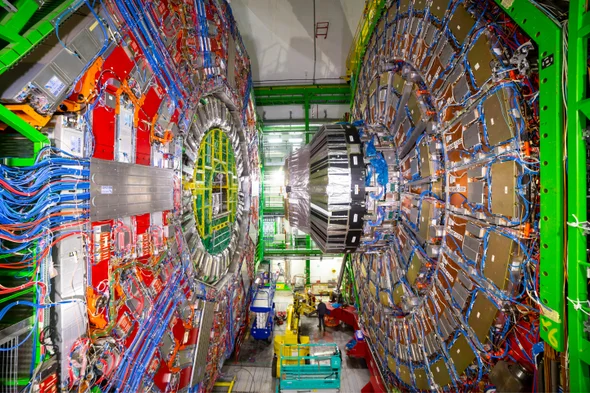10 Years after the Higgs, Physicists Are Optimistic for More Discoveries
Imagine that you have just arrived on a planet in another solar system. Suddenly, five minutes after you landed, you spot an alien life-form. This is an amazing discovery! You may well spend decades trying to understand this exotic being, probing its properties and investigating how it came to be there. At the same time, you expect that there may be other fascinating creatures around, maybe even more intriguing than the first and possibly much harder to get a glimpse of.
想象一下,你刚刚到达另一个太阳系的一个行星。突然,在你着陆五分钟后,你发现了一个外星人。这是一个惊人的发现!你可能会花上几十年的时间去理解这种奇异的生物,探索它的属性,并研究它是如何出现在那里的。与此同时,你可能会想到周围还有其他迷人的生物,可能比第一个更有趣,也可能更难一瞥。
This is how it feels for particle physicists as we begin a new phase, called Run 3, at the world’s most powerful particle accelerator: the Large Hadron Collider (LHC) at CERN near Geneva. This month marks the 10th anniversary of the discovery of the Higgs boson, a long-sought particle that had been predicted almost 50 years earlier. The LHC was built to find the Higgs boson and it did. Its next goal is to find clues to help us decipher other unresolved mysteries. Although the machine has not yet uncovered other novel fundamental particles—especially the hoped for supersymmetric particles that popular theories predicted and may still be out there—since the Higgs boson, the future at the LHC is promising. We have many new avenues to explore and many reasons for optimism.
这就是当我们在世界上最强大的粒子加速器——日内瓦附近欧洲核子研究中心的大型强子对撞机(LHC)——开始一个称为Run 3的新阶段时,粒子物理学家的感受。本月是希格斯玻色子发现十周年,希格斯玻色子是一种长期以来人们一直在寻找的粒子,早在50年前就有人预测过它。大型强子对撞机是用来寻找希格斯玻色子的,它做到了。它的下一个目标是找到线索,帮助我们破译其他悬而未决的谜团。尽管该机器尚未发现其他新的基本粒子,特别是流行理论预测的超对称粒子,并且自希格斯玻色子出现以来可能仍然存在,但大型强子对撞机的未来很有希望。我们有许多新的探索途径和许多乐观的理由。
The Higgs boson discovery, which came just four years after the LHC opened, was a lucky strike—it could have taken much longer to detect the particle, or we might never have found it at all. The particle’s mass might not have been in the range accessible at the collider, or it might not have interacted enough with other particles to be produced in the LHC collisions. It might not even have existed at all. And nature was even kinder: for reasons that we don’t yet understand, it arranged for the Higgs boson’s mass to be 125 times the mass of a proton, a value that causes the Higgs to decay at rates similar to those of many of the particles we know. This property makes it convenient to explore how the Higgs boson talks to these other particles and opens many opportunities to look for the unexpected.
希格斯玻色子的发现是一个幸运的发现,它发生在大型强子对撞机(LHC)开放后仅仅四年,它可能需要更长的时间来检测粒子,或者我们可能根本就没有发现它。粒子的质量可能不在对撞机可以达到的范围内,或者它可能没有与LHC碰撞中产生的其他粒子发生足够的相互作用。它甚至可能根本不存在。大自然甚至更友善:出于我们尚不了解的原因,它将希格斯玻色子的质量安排为质子质量的125倍,这个值使希格斯粒子以类似于我们所知的许多粒子的速率衰减。这一特性使我们能够方便地探索希格斯玻色子如何与这些其他粒子对话,并为寻找意外情况提供了许多机会。
Read more at ScientificAmerican.com
更多资料请移步科学美国人











